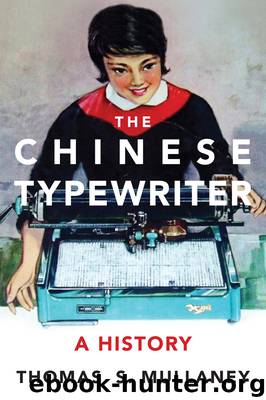The Chinese Typewriter by Thomas Mullaney

Author:Thomas Mullaney
Language: eng
Format: epub
Tags: technolinguistics; language; technology; linguistics; HCI; human computer interaction; China; culture; media studies; modernization; modern; typing; predictive text
Publisher: The MIT Press
Published: 2017-09-29T04:00:00+00:00
Between Technolinguistic Worlds: Kana, Kanji, and the Ambivalent History of Japanese Typewriting
Beginning in the second half of the nineteenth century, China’s neighbor to the east began to wrestle with its own questions of technolinguistic modernity, as exemplified in the history of Japanese telegraphy, telephony, industrialized printing, post, stenotype, and more.5 As Ryōshin Minami has shown, Japan’s printing industry was one of the country’s earliest and most thoroughly mechanized.6 Beginning in 1876, the application of steam power to printing revolutionized the domestic newspaper industry, enabling Japanese publishers to keep pace with a voracious and growing appetite for daily newspapers.7 During the second half of the nineteenth century, telephone and telegraph technologies were introduced in a timeline that runs roughly parallel to that of the Qing.8 In 1871, the same year Great Northern and Cable and Wireless promulgated the Chinese telegraph code, a telegraph code for Japanese kana was authored as well. Known alternately as the Japansk Telegrafnøgle (Japanese telegraph key) or Denshin jigō (telegraph signals), the code assigned short and long pulses to Japanese katakana syllables, arranged according to the predominant dictionary sequence of the era, the iroha taxonomic system (named after the eponymous Heian-era poem).9 With the Japanese state’s establishment of a monopoly over telecommunications and postal services, and with the expansion of Japan’s overseas informal and formal empire in the 1880s and 1890s, this network began to expand rapidly.10
The history of typewriting in Japan is inseparable from the broader history of nineteenth- and twentieth-century language reform and modernization efforts in East Asia, as well as the era’s widespread critique of character-based writing. Indeed, calls for the abolition of characters began sounding in Korea and Japan before they did in China. As part of “decentering the Middle Kingdom,” in the apt terminology of one historian, a branch of Korean reformers began to particularize and de-universalize symbols and ideologies inherited from the Chinese cultural sphere. Believing that a “break with the transnational culturalism of the East Asian past was necessary,” these reformers reserved particular enmity for hanja—Chinese character-based script that had been imported and applied to the Korean language many centuries prior—regarding it as a fundamental hindrance to the project of scientific (read Western) development.11 Once regarded as the chinmun or “truth script,” the character-based component of the Korean writing system steadily became particularized as foreign—as Chinese characters judged “merely in terms of their merits and a communicative tool.”12 Hanja came to be understood as irredeemably wedded to the very doctrines of Confucianism and Daoism now under attack as inherently antimodern. Bringing to mind Ernest Gellner and later Benedict Anderson’s examination of “truth language”—hierolects such as church Latin, Old Church Slavonic, or “examination Chinese” that were once understood to offer exclusive access to the canon of truth—the privileged position of such language necessarily eroded once this underlying truth was increasingly regarded as false.13
Japanese reformers mounted strikingly similar arguments during this same period, attempting to decouple their country’s fate from the sick man of Asia and thereby partake in the global project of modernity.
Download
This site does not store any files on its server. We only index and link to content provided by other sites. Please contact the content providers to delete copyright contents if any and email us, we'll remove relevant links or contents immediately.
| Africa | Americas |
| Arctic & Antarctica | Asia |
| Australia & Oceania | Europe |
| Middle East | Russia |
| United States | World |
| Ancient Civilizations | Military |
| Historical Study & Educational Resources |
The Sympathizer by Viet Thanh Nguyen(4335)
The Rape of Nanking by Iris Chang(4165)
World without end by Ken Follett(3445)
Ants Among Elephants by Sujatha Gidla(3438)
Blood and Sand by Alex Von Tunzelmann(3164)
Japanese Design by Patricia J. Graham(3135)
The Queen of Nothing by Holly Black(2538)
City of Djinns: a year in Delhi by William Dalrymple(2528)
Foreign Devils on the Silk Road: The Search for the Lost Treasures of Central Asia by Peter Hopkirk(2441)
India's Ancient Past by R.S. Sharma(2432)
Inglorious Empire by Shashi Tharoor(2410)
Tokyo by Rob Goss(2403)
In Order to Live: A North Korean Girl's Journey to Freedom by Yeonmi Park(2357)
Tokyo Geek's Guide: Manga, Anime, Gaming, Cosplay, Toys, Idols & More - The Ultimate Guide to Japan's Otaku Culture by Simone Gianni(2343)
India's biggest cover-up by Dhar Anuj(2333)
The Great Game: On Secret Service in High Asia by Peter Hopkirk(2313)
Goodbye Madame Butterfly(2221)
Batik by Rudolf Smend(2150)
Living Silence in Burma by Christina Fink(2047)
